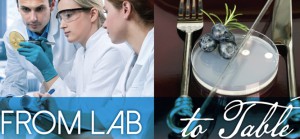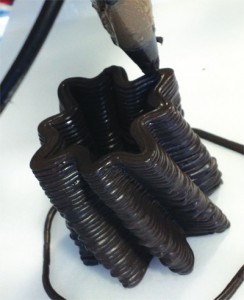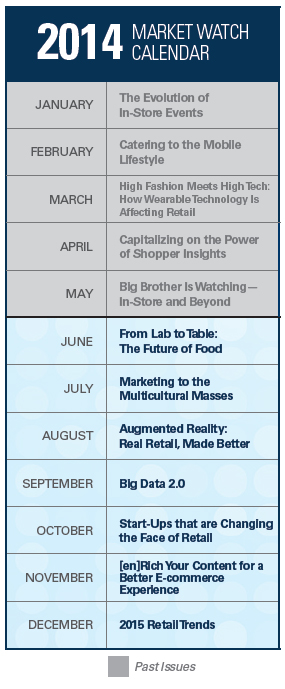 By Retail News Insider
By Retail News Insider
Consider two images. In the first, there’s a beautiful green pasture with animals happily grazing and a garden chock full of delicious vegetables. In the second, scientists dressed in stark white coats swirl concoctions in their flasks and analyze the results of their latest experiments. What do those two images have in common? They both represent places where our food comes from.
For a long time, the lab was mainly a source of processed food flavor and shelf- and freezer-stability innovations. In the last couple of years, however, science and technology have started to take on a much greater role, even to the point of being able to create foods “from scratch”—no soil or breeding required. Is this so-called “lab-to-table” food more than just a fad? Absolutely, say food scientists. In fact, it may hold the keys to delivering the increasing personalization consumers seek, reducing our environmental footprint and even meeting the nutritional demands of the world’s ever-growing population.
One technology that’s been making headlines in a variety of industries over the last few years is 3-dimensional (3D) printing. Using liquid plastic or metal instead of ink, printers are available today that allow businesses and individual consumers alike to create useable objects—from machine replacement parts to toy building blocks—anytime, anywhere. Later this year, a 3D printer that uses sugar and chocolate as its ink is expected to be released, enabling bakers and chefs to create complex, edible figures and structures right on their kitchen counters.
Though not yet commercially available, numerous technology firms—and even NASA—are working on 3D printers that will produce actual meals. The printers currently in the works use special food-based pastes to recreate various flavors and textures. But as the technology evolves, it’s possible they might be created from the actual individual proteins, carbohydrates and fats that make up food.
As NASA’s involvement illustrates, this technology is far from being just a gimmick. NASA points out that being able to print food in space would minimize waste and allow astronauts to customize their food, thereby ensuring the right nutrition needed to maintain health and performance. Here on Earth, the 3D food printers could similarly minimize food waste scraps (no potato peelings or orange peels to toss away) and allow for easy customization and personalization of restaurant meals, “home-cooked” entrees or even in-store product samples.
“In the next 75 years, the general public is going to be able to completely customize what they want as their culinary experiences [through 3D printing],” said food scientist Jay Gilbert in a recent interview with FutureFood 2050, a project of the Institute of Food Technologists. We may no longer need separate sections in the grocery store for gluten-free, low-carb or sugar-free foods. Instead, such nutritional needs could be controlled simply by the ink used in the printer.

3D printed chocolate dessert
Photo courtesy of Natural Machines
Another area of great interest is technologies that allow for the production of plant-based “meats.” One company, Beyond Meat, has already released a product (available in limited markets) that uses special machines and heat to take the protein building blocks that come from certain plants to create products that look, taste and feel like chicken or ground beef when you eat them. Other meat alternatives to beef steaks and pork are in the works. These alternatives are a far cry from the rubbery “tofurky” and soy dogs of the 1990s. “I tasted Beyond Meat’s chicken alternative and was impressed. I couldn’t tell the difference between Beyond Meat and real chicken,” writes philanthropist, Microsoft co-founder and Beyond Meat investor Bill Gates on his website.
Proponents of plant-based meat alternatives note these products are not only healthier (containing no cholesterol, saturated fat or trans fat), but also better for the environment. Per pound, it takes significantly less water to grow the plants that make up these products than to feed and care for livestock. The process also produces less waste. “People have a sort of hopelessness about climate change… but 51 percent of greenhouse gas can be attributed to livestock. If we were to reduce meat consumption globally by 25 percent, we could address a huge amount of the climate change problem,” said Beyond Meat founder Ethan Brown in an interview with CBS This Morning.
 A similar environmental rationale is a large part of what’s driving the most futuristic of food concepts: lab-grown food. In 2013, the first lab-grown hamburger was produced. The meat was created by taking a few cells from a cow and culturing them in a lab until they grew into the tens of thousands of cells that made up the “cultured beef” patty. This technology is currently very expensive and a long way off from regular commercial production. But scientists estimate that one day, a similar single sample of cells could be used to make over 44,000 lbs. of cultured beef.
A similar environmental rationale is a large part of what’s driving the most futuristic of food concepts: lab-grown food. In 2013, the first lab-grown hamburger was produced. The meat was created by taking a few cells from a cow and culturing them in a lab until they grew into the tens of thousands of cells that made up the “cultured beef” patty. This technology is currently very expensive and a long way off from regular commercial production. But scientists estimate that one day, a similar single sample of cells could be used to make over 44,000 lbs. of cultured beef.
Not only would lab-grown meat minimize the impact on the environment, experts also say it would allow us to produce a much greater amount of food than we currently can with the resources available on Earth. A 2011 report from the University of Oxford estimated that producing cultured meat would take just 2 percent of the land space currently used for livestock and use up to 60 percent less energy. Because of this, scientists envision it could become a vital method of supporting the ever-expanding human population, expected to reach 9.6 billion people by 2050.
Individual health could also benefit from lab-grown foods. “As we understand more about human nutritional needs, we can then develop foods specifically to help people meet their dietary goals,” says Dr. Mary Ellen Camire, President-Elect of the Institute of Food Technologists. For example, it might be possible to create dairy products, eggs, meat and beans that lack a specific protein that’s harmful to certain people with a disease called phenylketonuria (PKU). Today, people with this condition must limit their diets mainly to fresh fruits, vegetables and specific grains in order to avoid seizures and other serious health problems.
Thanks to technological innovations like these and new ones that are sure to follow in the coming years, the possibilities for the future of food—and their potential benefits to us as individuals and a society—are great. As Gates puts it, “The farm-to-table process hasn’t changed much over the last 100 years. Innovation in this [lab-to-table] sector has tremendous market potential.”

